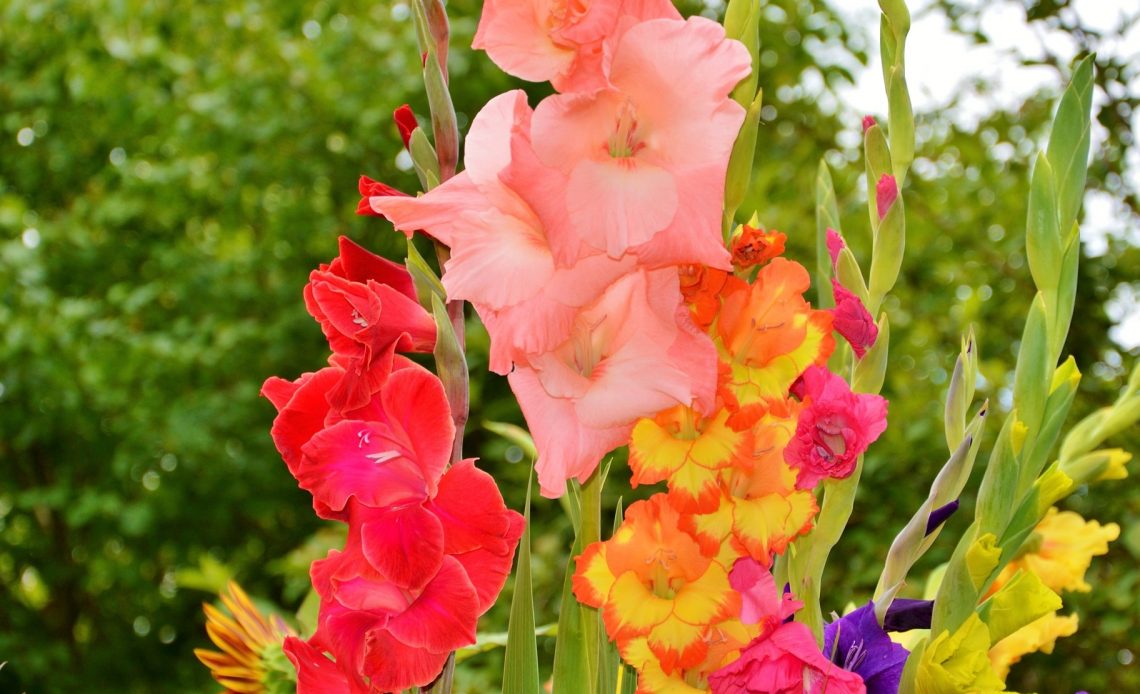

We’re here to help! Wild Yards is a completely free website that is 100% dedicated to helping you create a wildlife-friendly, sustainable yard. Read more
WildYards is reader-supported. When you buy a product through a link on our site, we may earn a comission. Every product is independently selected by our (obsessive) editors and our reviews are unbiased and objective. Read more about our mission or our privacy policy.
Butterflies may seem to enjoy fluttering around most flowers in your garden, but did you know that they, like people, have acquired tastes? Planting brightly-colored flowers with flat, open blooms is likely to attract these pollinators. But, do butterflies like gladiolus in particular?
Butterflies love gladioli. This multi-color, summer-blooming flower is bold, bright, open-faced, and enjoys the full sun. For most species of butterfly, that’s everything they look for in the perfect flower.
Why do butterflies like gladioli?
Gladioli are some of the most vibrant plants you can grow in your wild yard – and with butterflies naturally attracted to reds, oranges and yellows, they are some of the most obvious flowers for pollinators to head to. Alongside these fiery shades, you can also grow gladioli in whites and purples, but they appeal less to butterflies.
Gladioli are easy for butterflies to access should they hunt for nectar across your garden. For example, these plants thrive in the sun’s full glare, and butterflies will rarely head for the shade unless they need to drink or cool down. Moreover, gladioli heads tend to be open in shape – making it easy for the roving butterfly to perch while drinking nectar.
What’s interesting about the gladiolus is that it occupies a ‘middle-ground’ when it comes to the perfect shape. Butterflies prefer flowers where they can easily perch while feeding. Hummingbirds, meanwhile, need flowers they can feed on with their long beaks – thus, they seek out tubular specimens. Take a look at your gladioli, and you’ll find that their flowers are neither too trumpet-shaped nor too flat!
When grown to full maturity, the gladiolus is a fairly tall plant, with some specimens potentially reaching an impressive five feet. You’ll likely find most gladioli growing to a height of at least two feet – meaning in either case, they’re at optimum stature for fluttering butterflies to visit. This stature, of course, also helps their flowers stand out from the crowd!
Intriguingly, the gladiolus has inspired several studies regarding flower height potential. For example, did you know the closer you plant gladioli together, the taller they grow?
Butterflies, meanwhile, have also evolved to learn that gladioli have a reputation for giving off lots of nectar. This also means that they have plenty of competition. Not only are they sought-after by butterflies and hummingbirds, but bees, too. Many gardeners choose to plant an array of different gladioli – to provide an ample feast for visiting creatures.
Growing gladioli to attract butterflies
Growing gladioli to attract butterflies into your yard is surprisingly simple, and you should start by choosing a bright part of your garden that is in full sunlight or at least has access to sunlight for most of the day. Be sure to grow or propagate gladioli in warmer colors – think yellows and reds.
For the best results, gladioli need well-drained soil and fertilizer, and should never be kept too wet. If the soil keeps moisture for too long, then the corms will rot. So, if you are concerned about the quality of the ground soil, then opt for planting them in a raised bed. This works to the butterfly’s advantage, keeping the plants higher off the ground (where they rarely venture).
Fertilize your soil before planting (I’d recommend an organic blend), and keep more on standby for when your gladioli reach full bloom. You’ll need to top up on a little feed for every ten inches your gladioli grow to keep butterflies coming back.
You should plant the corms about six to ten inches apart to ensure plenty of room to grow. The bigger the corm, the deeper it should be in the soil, too.
Be warned, gladioli can fade after a short time no matter how careful you are. Plant more gladioli corms every two to three weeks during the warm seasons to keep butterflies interested. This will mean you have a near-constant crop regardless of which wilt and die.
While growing, gladioli may need help standing up – so be prepared to plant stakes in your soil to support them as they get heavier.
If you live in USDA zone seven or upwards, you’ll be ‘glad’ to know that these plants fare well in the winter. They’re not so hardy below zone seven, so be prepared to dig up your corms around the fall for replanting next year. If deadheading, try and leave a few leaves – four or five should do – as this will help them thrive when the spring rolls back around.
Are gladioli the best flowers for attracting butterflies?
The gladiolus is a short-lived but reliable butterfly attractor, but be sure to also plant a crop of azaleas, dianthus, zinnias, hibiscus, daisies, and sunflowers. Butterflies prefer varied diets with nectar from lots of different sources, and what’s more, they will likely have plenty of pollinator competition, too, so be sure to plant more than purely gladioli in your garden to attract butterflies.
Gladioli are wonderful butterfly attractors while you are lucky to have them – but always be sure to carefully feed and water to get the best out of these flowers. Butterflies will always flutter to them as favorites – just be careful to back them up with a few other flowers to boost your garden’s appeal.
